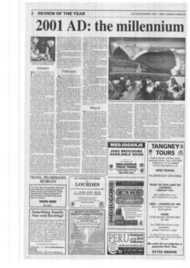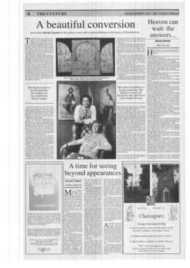Page 4, 28th December 2001
Page 4

Report an error
Noticed an error on this page?If you've noticed an error in this article please click here to report it.
Tags
Share
Related articles
Great Apologist Of The Catholic Faith
Leaders,`warts And All' Of The Second Spring
'the Second Spring'
Father Of The Post Conciliar Church
A Cardinal For All Men
Ushering in another second spring
Newman prophesied a second
spring for Catholicism in England. The amazing achievements of the Victorian Church were a partial More recently, severe winds
fulfilment of that prophecy.
have perished many of the
buds and flowers. So be it. What would an English spring be without some sudden frost?
On cold winter days when the light disappears early, we are not inclined, temperamentally, to credit nature's promise. But in the stony ground of the contemporary Catholic Church in England seeds are sprouting and showing green. One of these is the Centre for Faith & Culture at Oxford, founded in 1994 and currently located at Plater College on Headington Hill.
As a vantage point for viewing Oxford, Headington Hill is less well known than Cumnor Hill, which lies to the west across the valley of the twin rivers, the Cherwell and the Thames. But near to Plater is a break in the trees and villas, and through it you can see those dreaming spires quite as well as from anywhere.
What is it they dream of, those spires that witnessed the coming of the New Learning and the Reformation, the English Enlightenment (such as it was) and the struggle of Whig and Tory, as well as Tractarianism — the "Oxford Movement" par excellence. Neo-Hegelianism, and the spectacular development of the natural sciences, and finally linguistic philosophy and the post-modern avantgarde?
0 nly Catholics know the answer to that question. The spires of the churches, and the chapels of the colleges, dream of the Mass's return to the mystical Golgothas of their altars. They dream of the expansion of the university's horizons to the infinity of God, thanks to divine revelation. the greatest truth ever known.
The Centre for Faith & Culture testifies to that reality about which the spires dream. What strikes me in going through its recent literature is the sheer range of activities that it seems to have generated — for liturgists, for economists, for artists, for young pilgrims. Behind it all is Stratford Caldecott — for most of his life a professional publisher with Routledge, HarperCollins and most recently the Edinburgh firm T & T. Clark — together with his wife, the writer Leonie Caldecott. They met at Oxford while undergraduates, but only after their marriage did each decide to become Catholic. They are extraordinarily apostolic people, but without intemperate zeal because, as is apparent from their writings as well as their personalities, they are very clear that in any Christian life, contemplation is what comes first.
They probably will be embarrassed at my saying so, but what they are doing perfectly reflects the programme John Henry Newman (one of their heroes) set himself: to make the Catholic Church fit for converts to live in.
A more adequate liturgical practice that is God-centred and has the measure of the liturgy's cosmic dimensions; concrete proposals for a political economy that will earth Catholic social teaching in the service of a society of households; the revival of sacred art for our places of worship as well as our homes; initiating girls into a Catholic feminism that is properly womanly: the tasks the centre has set for itself and its collaborators are clearly contributing to Newman's aim.
But these partial agendas need an overall context, and this is where the centre's conferences come in. The topics and speakers are carefully chosen so as to forward a particular vision of Catholicism.
This may alert the suspicious reader. But the particular vision the Caldecotts put forward is, paradoxically, a universal one. It is a vision of a Catholicism that is maximally generous: able to integrate all that is good, true and beautiful no matter where it comes from. The thinkers they patronise: Newman, Chesterton, Balthasar, Soloviev, Christopher
Dawson, and not least the present Pope, all instantiate that generosity of temper in various ways. The presence of the Russian Orthodox
thinker Soloviev in that list can also stand for the ecumenical outreach of the centre. The Caldecot t S. together with their close colleague at Plater, Dr Gregory Glazov, are surely right in regarding the dialogue with Eastern Orthodoxy as potentially the most fruitful ecumenical conversation for the Catholic Church.
It's difficult to think of any Catholic institution in England with either a comparable range of interests, or a comparable coherence of outlook.
And the amazing thing is that this has been done with minimal financial resources — though the centre is hosted by Plater College and has now joined itself to the (North American) Chesterton Institute, which is launching an appeal on its behalf. The Centre in fact maintains at Plater a fine Chesterton archive, built up by the exertions of Mr Aidan Mackey. This includes not only books,
by the way, but household
objects that bring GKC touchingly close: like his battered typewriter, and the toy theatres that were a passion of that childlike man.
Chesterton's stature is increasingly recognised in the Englishspeaking world beyond this island. One of the purposes for which the centre needs benefactions is precisely in order to give this rich material a setting fit for it.
To be honest, it is really rather shameful that the Catholic Church in England — whether officially or in its laity — has not been generous with its temporal goods for the sake of helping an organisation that so adequately represents the generosity of Catholicism itself.
But of course part of the reason is that people —busy bishops and the woman in the pew —just don't know of it. Hence this modest appeal to hearts, minds, and purses. To find out how you could help the work of the Centre for Faith & Culture, contact Stratford at Plater College, Pullens Lane, Oxford 0X3 ODT.
But steady on, you may say. I want to find out more first. Since its foundation the centre has put out a twiceyearly bulletin, which this year became an illustrated "Journal of Faith and Culture" with the title Second Spring. In the first issue a feast is laid for which I here have provided only the most elementary hors d'oeuvre. Labour and liturgy, art, theology and devotion are interthreaded in this first number, a smaller version of the tapestry the Caldecotts and their associates have set themselves to weave. Subscription information for the second, New Year issue is available on an associated website: www. secondspring.conk.
The most celebrated view of Oxford, I said, is from Cumnor Hill. It became famous after Matthew Arnold made it the setting of "The Scholar Gipsy", his poem about a student drop-out who learns from sources beyond the university — from gipsies but also from Mother Nature herself — truths pure scholarship cannot know.
Perhaps the Centre for Faith & Culture is a corporate Catholic Scholar Gipsy, looking out at Oxford from a place where other sources of wisdom rise and mingle their waters in a wide deep pool.
blog comments powered by Disqus











